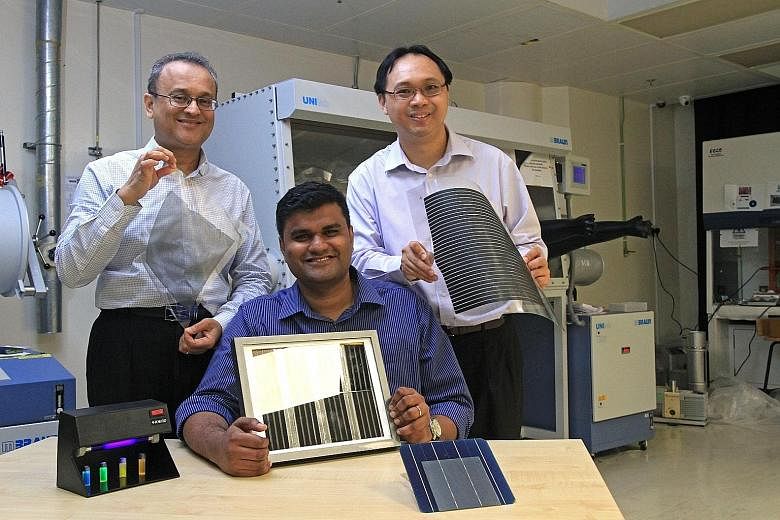Singapore receives plenty of sunlight, but less than 2 per cent of its power supply comes from the sun.
A team of scientists at the Nanyang Technological University (NTU) wants to increase this.
How? One way is to cover every available surface in Singapore with solar panels, from the roofs of bus stops, to sloping building facades, and perhaps even the billboards along Orchard Road.
Last week, the researchers showed The Straits Times a prototype of what a flexible solar panel could look like - a 30cm by 30cm plastic sheet with a material called perovskite printed on it.
Conventional silicon-made solar panels are brittle and inflexible. But it is a different story if they are made of this "wonder material", which the scientists believe could revolutionise the solar industry here.
Perovskite used in making solar cells are synthesised in laboratories from elements such as carbon, hydrogen, nitrogen, lead and iodine. Like silicon, perovskite can convert sunlight into electricity.
But while silicon exists mainly as a breakable solid, perovskite can be printed onto plastic sheets - making flexible solar panels a possibility.
Various liquid chemicals, including the perovskite, are mixed together. The solution is then poured into a screen printer, such as those used in the T-shirt printing business, and printed onto sheets of plastic or glass.
Professor Subodh Mhaisalkar, executive director of NTU's Energy Research Institute, said glass-printed perovskite solar panels could become commercially available within the next three years.
As perovskite is translucent, and its colour can also be adjusted through chemical processes, such solar panels could be integrated into building facades.
This is not possible with current silicon-made solar panels, which are opaque and would block out light.
Prof Subodh is confident that new solar cell technologies, such as perovskite solar cells, could help the Republic tap more sunlight than ever before.
Perovskite panels allow sunlight to be harvested in places where solar energy cannot be tapped with silicon panels, such as on building facades and windows.
These perovskite panels would also be cheaper to produce, costing about three times less than conventional silicon cells, he said.
This is because perovskite can be printed onto large sheets of glass or plastic using printers similar to those used in the T-shirt printing business - doing away with the need for expensive materials and equipment required for manufacturing silicon solar cells.
The team also discovered that other than absorbing energy for conversion into electricity, perovskite nanoparticles can also emit light.
This allows for the potential application where a perovskite screen could function as both a display screen and solar panel, said the scientists.
The NTU team is working with scientists from the Singapore-Berkeley Research Initiative for Sustainable Energy on the perovskite research.
It also received funding from the National Research Foundation's Competitive Research Programme, which disburses funding of up to $10 million.
The National Research Foundation said: "Through the collaboration, we hope to achieve research and development breakthroughs that drive competitiveness of photovoltaic, which can in turn spur greater (solar) adoption in Singapore.
"This is key to achieving longer-term energy sustainability and security for Singapore."


